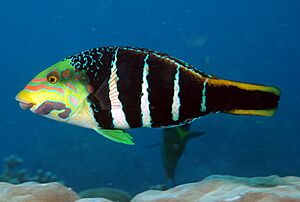Barred thicklip facts for kids
Quick facts for kids Barred thicklip |
|
|---|---|
 |
|
| Conservation status | |
| Scientific classification | |
| Synonyms | |
|
The barred thicklip wrasse (scientific name: Hemigymnus fasciatus) is a colorful fish from the wrasse family. You can find it in the warm waters of the Indo-Pacific Ocean. This fish is known for its thick lips and cool color changes as it grows up!
Contents
What Does a Barred Thicklip Wrasse Look Like?
The barred thicklip wrasse is a medium-sized fish. It can grow to be about 30 to 50 centimeters long. That's about the length of a school ruler!
Its body is tall and a bit flat. It has a big head and a mouth with very thick lips. The colors of this fish change a lot depending on how old it is.
Young Wrasses: The Juvenile Look
When the barred thicklip wrasse is young, it's called a juvenile. It has a yellow-green body. On its body, you'll see six yellow stripes going up and down. Sometimes, there are thin black lines between the yellow ones, but they can be hard to see.
Adult Females: The Initial Phase
Adult females are in what's called the "initial phase." Their bodies are dark green to black. They have four white stripes going up and down. Their heads are green and white with pretty pink patterns. These pink patterns often have bright turquoise highlights. The tail fin of a female is orange.
Adult Males: The Terminal Phase
Older, mature males are in the "terminal phase." Their bodies are dark green to black, just like the females. They also have four white stripes. These stripes get thinner towards the top of their bodies. In very old males, these stripes might even fade away. The male's head looks like the female's. However, its patterns are much brighter. It has a special horseshoe-shaped pattern on its snout. The male's tail fin is the same color as its body.
Where Do Barred Thicklip Wrasses Live?
You can find the barred thicklip wrasse all over the tropical and subtropical parts of the Indo-Pacific Ocean. This huge area stretches from the eastern coast of Africa, including the Red Sea, all the way to Polynesia. It also goes from New Caledonia up to southern Japan.
Their Favorite Home Spots
These wrasses love places where corals, sand, and rocky bits are mixed together. They like to live in waters from the surface down to about 25 meters deep. These spots are perfect for finding food and hiding. Young wrasses are very shy. They always stay hidden in corals or even inside sea urchins to stay safe.
How Do Barred Thicklip Wrasses Live?
Barred thicklip wrasses usually live alone. But sometimes, you might see them swimming in small, loose groups. They are hunters that live near the bottom of the ocean. They mostly eat small sea creatures without backbones.
What Do They Eat?
They love to munch on things like:
- Crustaceans (like tiny crabs or shrimp)
- Molluscs (like small snails or clams)
- Worms
- Echinoderms (like sea stars or sea urchins)
They find their food on or in the sand and rocks at the bottom of the sea.
Changing Gender: A Cool Fact!
Like many other wrasse species, the barred thicklip wrasse is a protogynous hermaphrodite. This is a fancy way of saying that all individuals are born female. As they get older, some of them can change and become male!
Are Barred Thicklip Wrasses in Danger?
People do catch this fish for the aquarium trade. However, experts don't think this is a big threat to the species. The International Union for Conservation of Nature (IUCN) lists the barred thicklip wrasse as "Least Concern" (LC). This means they are not currently in danger of disappearing.


